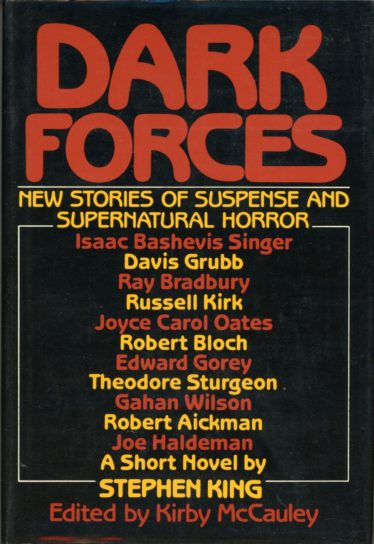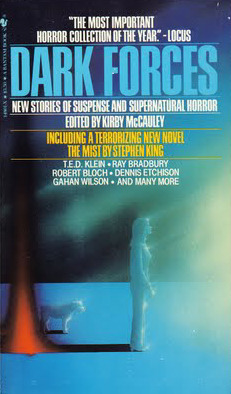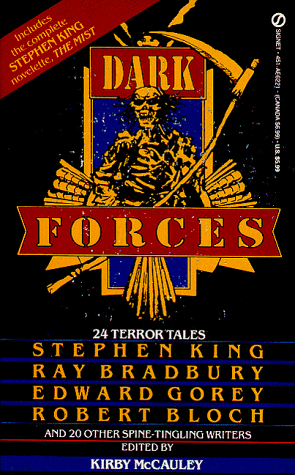 In my review of Ellen Datlow’s INFERNO (2007) I apparently ruffled a few feathers with my final sentence, in which I favorably compared INFERNO to the Kirby McCauley edited anthology DARK FORCES. Based on the feedback I’ve gotten, it seems many readers believe that I either don’t know what I’m talking about or was being insincere. Regarding that first point I can’t say for sure (plenty of evidence exists both for and against that assessment), whereas with the second I’m afraid I’ll have to plead guilty—I was indeed not being sincere in equating INFERNO and DARK FORCES because, frankly, I prefer INFERNO.
In my review of Ellen Datlow’s INFERNO (2007) I apparently ruffled a few feathers with my final sentence, in which I favorably compared INFERNO to the Kirby McCauley edited anthology DARK FORCES. Based on the feedback I’ve gotten, it seems many readers believe that I either don’t know what I’m talking about or was being insincere. Regarding that first point I can’t say for sure (plenty of evidence exists both for and against that assessment), whereas with the second I’m afraid I’ll have to plead guilty—I was indeed not being sincere in equating INFERNO and DARK FORCES because, frankly, I prefer INFERNO.
Datlow’s INFERNO, for those who don’t know, is an excellent collection of horror stories from several big names in the field (including Pat Cadigan, Christopher Fowler, Lucius Shephard and K.W. Jeter), and McCauley’s DARK FORCES was likewise a terrific grouping of horror stories. It appeared in 1980, at roughly the midway point of the horror boom, and in the eyes of many is not a standout anthology but, rather, the standout anthology. But is DARK FORCES really that great a book? Let’s see.
Kirby McCauley’s chief inspiration was the 1967 Harlan Ellison edited DANGEROUS VISIONS, often credited as the foremost grouping of science fiction stories ever published. Ellison’s mission statement was to elevate science fiction from the ghetto to which it was consigned, and McCauley had similar aspirations with DARK FORCES. As with DANGEROUS VISIONS (and its 1972 sequel AGAIN, DANGEROUS VISIONS), DARK FORCES contains stories by virtually all the big names in its field—Stephen King, Ray Bradbury, Richard Matheson, Robert Bloch, Robert Aickman, Theodore Sturgeon and Manly Wade Wellman all make appearances—along with (then) young turks like Dennis Etchison, Charles L. Grant and Lisa Tuttle, and no wonder: Kirby McCauley was a literary agent who represented quite a few of those names.
McCauley had previously edited the 1976 anthology FRIGHTS, which among other problems was too short, containing but 14 stories. For DARK FORCES McCauley commissioned a whopping 23 original tales, paired with a hardcover book jacket whose design was downright revolutionary in a field known—some might even say dependent on—gaudy cover art. The DARK FORCES cover, by contrast, was entirely black but for the title and the names of its contributors, a pretty ballsy move that implied the contents were strong enough to render snazzy cover art unnecessary.
 Of the stories collected in DARK FORCES there’s nary a clunker in the bunch, and three can even be termed exceptional: Stephen King’s novella-length “The Mist,” Dennis Etchison’s “The Late Shift” (perhaps the finest story he ever wrote) and the more literarily inclined “The Bingo Master” by Joyce Carol Oates. Three great stories is a good ratio, especially for an anthology appearing in 1981 (a time that wasn’t exactly known for standout horror/science fiction anthologies, as proven by the many mediocre 1970s era Roger Elwood edited compilations that had largely obscured the brilliance of DANGEROUS VISIONS). They are, however, but a small fraction of the book’s 23 story whole.
Of the stories collected in DARK FORCES there’s nary a clunker in the bunch, and three can even be termed exceptional: Stephen King’s novella-length “The Mist,” Dennis Etchison’s “The Late Shift” (perhaps the finest story he ever wrote) and the more literarily inclined “The Bingo Master” by Joyce Carol Oates. Three great stories is a good ratio, especially for an anthology appearing in 1981 (a time that wasn’t exactly known for standout horror/science fiction anthologies, as proven by the many mediocre 1970s era Roger Elwood edited compilations that had largely obscured the brilliance of DANGEROUS VISIONS). They are, however, but a small fraction of the book’s 23 story whole.
There’s “Mark Ingestre: A Customer’s Tale” by Robert Aickman, an odd though entirely characteristic hallucinatory tale by one of the genre’s most unpredictable practitioners (with allusions to SWEENEY TODD that Aickman insists on spelling out quite blatantly). “Dark Angel” by Edward Bryant is a smoothly written depiction of the doings of Angela Black, a modern-day witch who also figures in Bryant’s 1987 story “Haunted” and 1991 novella FETISH. “Children of the Kingdom” by T.E.D. Klein is an urban situated Lovecraftian pastiche with just the right hint of ambiguity. “The Detective of Dreams” by Gene Wolfe, about a dream master in a never-neverland, is said to be the author’s personal favorite story (Wolfe is something of an acquired taste that I’m not sure I’ve cultivated). “The Peculiar Denesme” by the late conservative firebrand Russell Kirk (another taste I have yet to acquire) is a very old school depiction of an inhuman monster in a distant land. There’s also “Traps,” an E.C. Comics worthy excursion in rodent phobia by Gahan Wilson, and “The Brood” by Ramsey Campbell, a very Cambellian depiction of apprehension that ranks about average its author’s cannon.
The same goes for the “Old Masters” tales collected here, with Sturgeon’s “Vengeance Is,” Bloch’s “The Night Before Christmas” and Bradbury’s “A Touch of Petulance” being decent but unexciting entries in those authors’ oeuvres. Ditto “Where There’s A Will” by Richard Matheson, in collaboration with his son Richard Christian, which registers as, at best, an amusing trifle (with an overabundance of single sentence paragraphs), and “The Stupid Joke” by Edward Gorey, a cartoon tale done up in Gorey’s inimitable funny-macabre manner that’s fun but not terribly inspiring.
As to why the book has such an exalted reputation, I’d say it has do with timing. The horror genre may have been in the midst of a boom in 1980, but that didn’t mean its output was boom-worthy. These stories, appearing amid a glut of tawdry killer crustacean and mutant insect potboilers, were thoughtful and solidly written, which it seems were just what critics and more discerning readers of the time wanted. The goodwill that greeted DARK FORCES’s appearance seems to have carried over into the ensuing decades, even though the book has long since been outdone.
 The 1980s contained several like-minded anthologies, among them a 1986 Dennis Etchison edited tome whose ambitions were laid out by its title—CUTTING EDGE—and 1998’s PRIME EVIL from editor Douglas E. Winter, about which, according to The Twilight Zone magazine, “Everything from the advance publicity to the book jacket to the contents page itself suggests none too subtly that surely this volume must be the state-of-the-art showcase for dark fantasy against which all others are measured”—in other words, a new DARK FORCES, a desire for which editor Al Sarrantonio made explicit in the introduction to his 1999 anthology 999, which he unhesitatingly proclaims “the biggest, the most lavishly appointed, and (we think, hope, and pray) the finest collection of brand-new horror and suspense stories ever published.”
The 1980s contained several like-minded anthologies, among them a 1986 Dennis Etchison edited tome whose ambitions were laid out by its title—CUTTING EDGE—and 1998’s PRIME EVIL from editor Douglas E. Winter, about which, according to The Twilight Zone magazine, “Everything from the advance publicity to the book jacket to the contents page itself suggests none too subtly that surely this volume must be the state-of-the-art showcase for dark fantasy against which all others are measured”—in other words, a new DARK FORCES, a desire for which editor Al Sarrantonio made explicit in the introduction to his 1999 anthology 999, which he unhesitatingly proclaims “the biggest, the most lavishly appointed, and (we think, hope, and pray) the finest collection of brand-new horror and suspense stories ever published.”
I’m not sure I agree with that assessment, although I fully acknowledge 999 is a standout anthology. So too are CUTTING EDGE and PRIME EVIL, and I while have no idea where the David J. Schow compiled SILVER SCREAM (1988) and the D.M. Mitchell edited THE STARRY WISDOM (1994) rank in the overall consensus, I say they deserve to be added to the Great Horror Anthology firmament.
In truth, however, this entire argument is largely moot. The best post-DARK FORCES horror anthologies are in fact those containing previously published, and acknowledged classic, tales, such as the David G. Hartwell edited DARK DESCENT and THE WEIRD from Jeff and Ann VanderMeer, which taken together represent the greatest grouping of horror stories ever assembled, period. It’s those books I’d recommend to people in search of a great horror anthology, followed by CUTTING EDGE, PRIME EVIL, SILVER SCREAM, THE STARRY WISDOM, INFERNO and, if they have the time, DARK FORCES.
